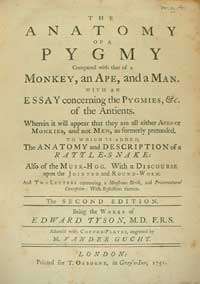Edward Tyson

Edward Tyson (20 January 1651 – 1 August 1708) was a British scientist and physician, commonly regarded as the founder of modern comparative anatomy,[1] which compares the anatomy between species.
Biography
Tyson was born the son of Edward Tyson at Clevedon, in Somerset. He obtained a BA from Oxford on 8 February 1670, a MA from Oxford on 4th November 1673, and a MD from Cambridge in 1678. He was admitted to the College of Physicians on 30 September 1680 and as a Fellow in April 1683. In 1684 he was appointed physician and governor to the Bethlem Hospital in London (the first mental hospital in Britain, second in Europe). He is credited with changing the hospital from a zoo of sorts to a place intended to help the inmates. He was elected a Fellow of the Royal Society in November 1679. He is buried at St Dionis Backchurch.[2]
Anatomical research

In 1680, Tyson studied a porpoise and established that porpoises are mammals. He noted that the convoluted structures of the brains were closer to those of land quadrupeds than those of fish.[3][4] In 1698, he dissected a chimpanzee and the result was the book, Orang-Outang, sive Homo Sylvestris: or, the Anatomy of a Pygmie Compared with that of a Monkey, an Ape, and a Man. In this book he came to the conclusion that the chimpanzee has more in common with man than with monkeys, particularly with respect to the brain. This work was republished in 1894, with an introduction by Bertram C. A. Windle that includes a short biography of Tyson.[2]
Tyson dissected a timber rattlesnake in 1683 and produced one of the earliest and most accurate descriptions of the internal anatomy of snakes. He was the first to describe the loreal pits of the Crotalinae. Tyson however did not recognize its heat sensing function but thought it to be a hearing organ.[5][6]
See also
References
- ↑ Newman C (October 1975). "Edward Tyson". Br Med J. 4 (5988): 96–7. doi:10.1136/bmj.4.5988.96. PMC 1674957
 . PMID 1102061.
. PMID 1102061. - 1 2 A philological essay concerning the pygmies of the ancients. London: David Nutt. 1894.
- ↑ Tyson, Edward (1680). Phocaena, or the Anatomy of a Porpess, dissected at Gresham College: with a preliminary discourse concerning Anatomy, and a Natural History of Animals.
- ↑ Kruger, Lawrence (2003). "Edward Tyson's 1680 Account of the 'Porpess' Brain and its Place in the History of Comparative Neurology". Journal of the History of the Neurosciences. 12 (4): 339–349. doi:10.1076/jhin.12.4.339.27915.
- ↑ Ahrenfeldt, R. H. (1955). "Two British Anatomical Studies on American Reptiles (1650-1750) II. Edward Tyson: Comparative Anatomy of the Timber Rattlesnake". Herpetologica,. 11 (1): 49–69.
- ↑ Tyson, Edward (1682). "Vipera caudisoma Americana, or the anatomy of a rattle-snake, dissected at the Repository of the Royal Society in January 1682-3". Philosophical transactions of the Royal Society of London. 13: 561–576.
Further reading
- Montagu, Ashley (1943) Edward Tyson, M.D., F.R.S., 1650-1708: And the Rise of Human and Comparative Anatomy in England; a Study in the History of Science. American Philosophical Society.